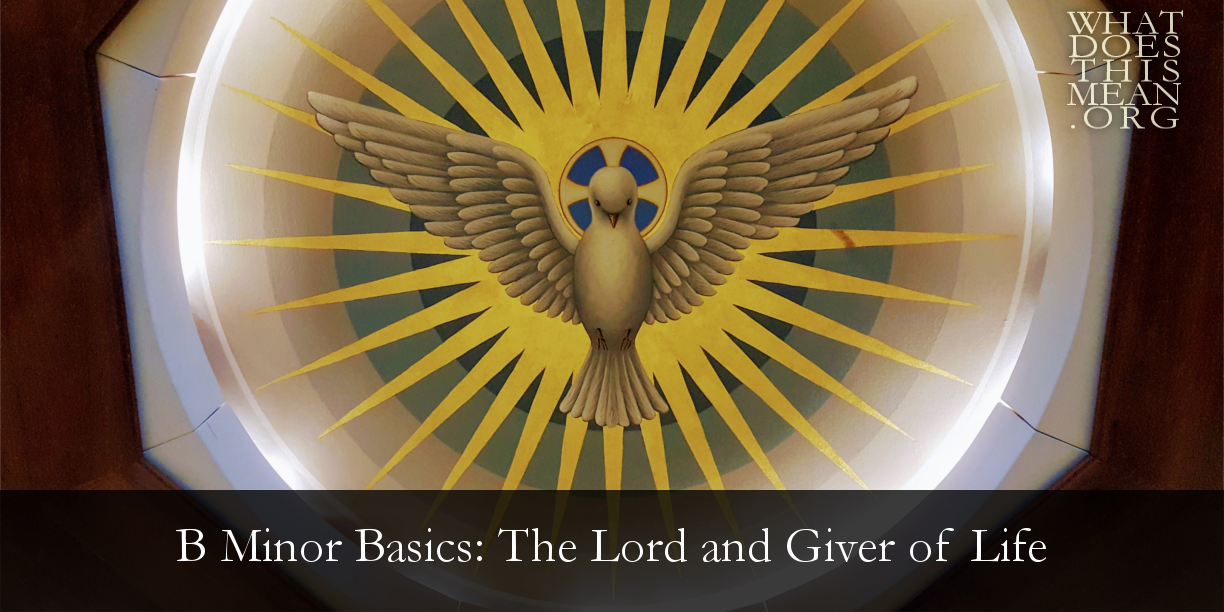And by the coming of the Holy Ghost, the Comforter:
Help us, good Lord.
Following the jubilant Et resurrexit, the Et in Spiritum Sanctum transitions to a charming aria for bass soloist, oboes d’amore (the “sweeter” or softer oboes available in Bach’s day), and continuo. In the following video, which begins with the Et resurrexit, listen to the transition from the full chorus and orchestra to the lilting, 6/8 meter, the gently rocking triplets, and the softer woodwind tones. As you listen to the bass solo, think about why Bach chose pastoral musical to depict the work of the Holy Spirit. (Please see the April 2016 issue of “Lifted Voice” for a complete commentary on the Et resurrexit.)
|
Et resurrexit tertia die
secundum scripturas Et ascendit in coelum, sedet ad dexteram Dei Patris; et iterum venturus est cum Gloria judicare vivos et mortuos: cujus regni non erit finis. [3:45] Et in Spiritum Sanctum, Dominum et vivificantem, qui ex Patre Filioque procedit, qui cum Patre et Filio simul adoratur et conglorificatur, qui locutus est per Prophetas. Et unam sanctam catholicam et apostolicam Ecclesiam. |
The third day He rose again
according to the Scriptures. And ascended into heaven, and sits on the right hand of God the Father; and He will come again with glory to judge the living and the dead: Whose kingdom will have no end. And in the Holy Ghost, the Lord and giver of life, who proceeds from the Father and the Son, who with the Father and the Son together is worshipped and glorified, who spoke by the Prophets. And [I believe] in one holy catholic and apostolic Church. |
So why is pastoral music used to depict the work of the Holy Spirit? May I suggest that the pastoral music, with its characteristic 6/8 meter and two oboes, simply depicts the work of Christ, the Good Shepherd, as He feeds His flock? In his Large Catechism, Martin Luther says, “Neither you nor I could ever know anything of Christ, or believe in him and take him as our Lord, unless these were first offered to us and bestowed on our hearts through the preaching of the Gospel by the Holy Spirit” (LC III.38). Christ is the Good Shepherd, who works through the Holy Spirit—the “Comforter,” as The Litany calls Him—to lead us into all truth. Far from renouncing interest in the text, Bach demonstrates his knowledge of theology by setting this pastoral text to pastoral music.
Two closely connected choruses, with no break between them, conclude the Credo: the Confiteor on Holy Baptism and Et expecto on the eschatological hope of the believer. The Confiteor is based in part on one of the historic chants associated with the Nicene Creed. Listen for a simple theme on the words, Confiteor unum baptisma in remissionem peccatorum, which serves as the main theme of this movement as it is passed from voice to voice in imitative fashion.
remissionem peccatorum. the remission of sins.
|
Et expecto resurrectionem mortuorum et vitam venture seculi. Amen. |
And I look for the resurrection of the dead, And the life of the world to come. Amen. |
The music takes a sudden and solemn turn at the words, “And I look for the resurrection of the dead.” The harmony lurches off course and descends into the dark regions of E-Flat minor, a key that was seldom used in Baroque music because it was incompatible with most tuning systems. The Passacaglia theme of the Crucifixus reoccurs in the bass line, the tempo slows to Adagio, and the voice leading is unpredictable, especially on the word mortuorum. What does this mean? May I suggest that this 24-measure bridge simply depicts what theologians call the now/not yet tension of the Christian life? We have one foot in the New Creation by virtue of our baptism now. But the fullness of the new heaven and the new earth is not yet.
In the end, the New Creation arrives, and it is marvelous in our ears! Conductor John Eliot Gardiner rightly connects the music to I Corinthians 15:
|
This is the stage [4:38 in the previous video] at which we might discern a Parallel with St. Paul’s mysterious moment when ‘we shall all be changed, in a moment, in the twinkling of an eye’ (I Corinthians 15:51-2). This then leads to the conviction . . .that ‘the dead shall be raised incorruptible’. At this point—‘at the last trump’—the dam finally breaks: et expecto now becomes credo resurrectionem mortuorum (Bach: Music in the Castle of Heaven, p. 511).
|
|
My flesh in hope shall rest / And for a season slumber
Till trump from east to west / Shall wake the dead in number: Had Christ, who once was slain, Not burst His three-day prison, Our faith had been in vain: But now has Christ arisen, arisen, arisen; But now has Christ arisen!
— Lutheran Service Book 482.3
|



 RSS Feed
RSS Feed
